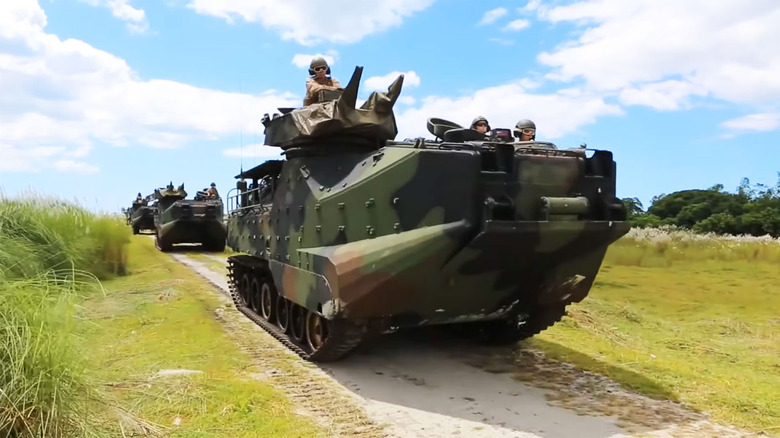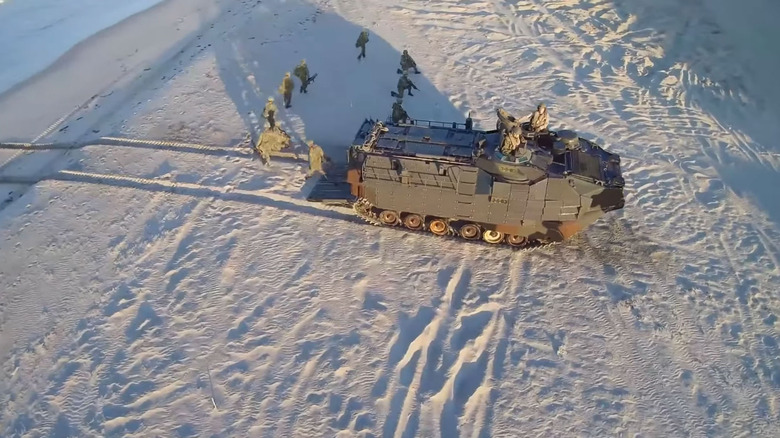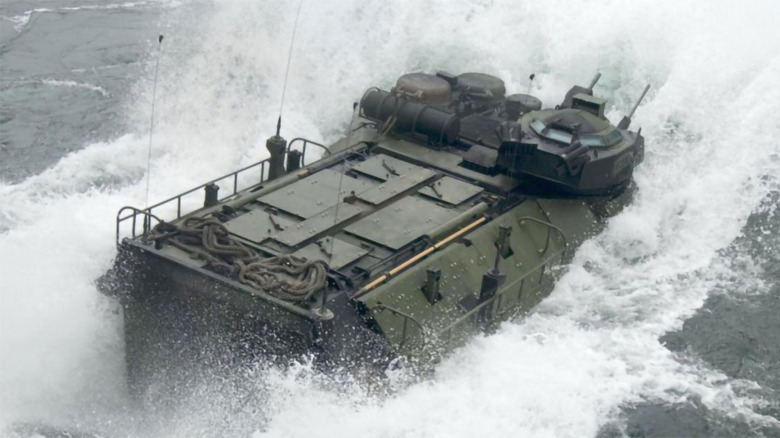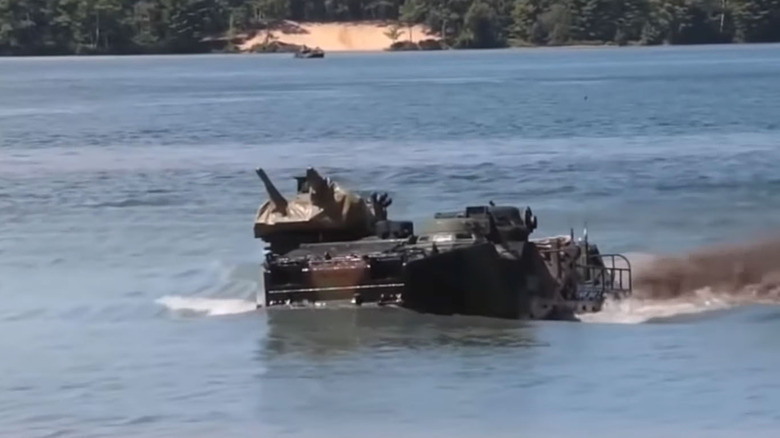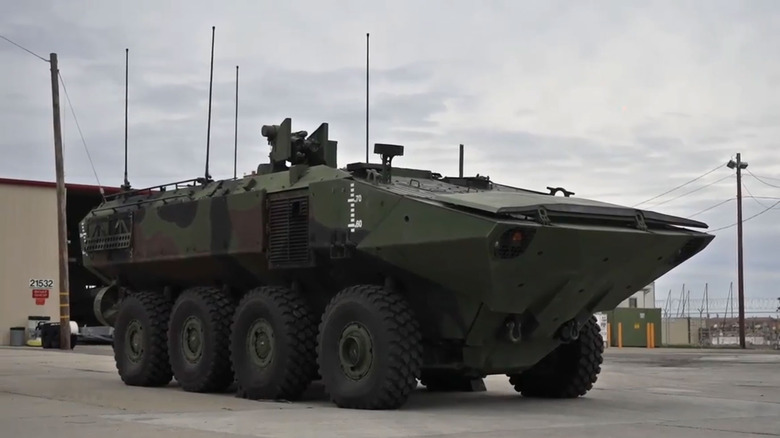Beach Breacher: The History Behind The Amphibious Assault Vehicle AAVP-7A1
In all of the most unforgettable and tragic scenes of war, perhaps no other image is as memorable as Allied troops storming the beaches of Normandy during World War II. The goal was straightforward but difficult to pull off, as a full land, air, and sea invasion required multiple points of attack.
Though that invasion would see the use of the Higgins boat primarily, the earliest iterations of the amphibious assault vehicle (AAV) were already being used by the U.S. Marine Corps in the Pacific Theater. While the initial versions were rudimentary and offered little protection with no offensive capabilities, future variations would become a critical component of militaries worldwide.
The AAVP-7A1 is part of the AAV7A1 family of amphibious military vehicles, also known as "amtrack," and was introduced in 1984 by BAE Systems. The AAVP7A1 is one of three variations for the vehicle and the Personnel Variant designed to provide combat support and armor for rifle squads in both land and sea operations for militaries across the globe.
The AAVP-7A1 comes from a long line of amphibious tractors
The U.S. Marines have used an iteration of the amphibious vehicles since 1941 when they were first deployed and later used in the Battle of Guadalcanal in the Pacific during World War II. This amphibious tractor was the first in a series of Roebling "Alligator" amphibious tractors, a series of sea and land assault & transport vehicles, with development starting all the way back in 1932. Originally dubbed the Landing Vehicle, Tracked, or LVT, over 18,000 were produced by the end of WWII and played a prominent role in operations during the conflict.
As superior as it was to alternatives like the General Motors DUKW, the original LVT wasn't perfect. The first "Gators" were only capable of going 2.5 mph at sea and 25 mph on land. Over time, the speed, armaments, and armor of the vehicle would be improved, leading to the LVT-1, a slight improvement over the earlier "Crocodile" model.
This version of the sea and land vehicle would go on to inspire several variations, including the LVTA1, LVTA2, and LVTA5, until finally, in 1984, the vehicle was redesignated from the LVTP-7 to the AAV7A1, the family of amphibious vehicles that would play a significant role in U.S. Marine Corps operations for the next two decades.
The AAVP-7A1's hardware has made it viable for over two decades
The AAVP-7A1 Personnel Variant has a 400-hp turbocharged diesel V-8 engine that gives it power for a maximum speed of 45 mph on land and 8.2 in the water. With a multitude of armaments, including an M2 HB caliber .50 machine gun, MK-19 40-mm machine gun, and M257 smoke grenade launchers, the multi-terrain vehicle is well-equipped to handle infantry and unarmored threats while hauling 21 fully-equipped combat troops.
The AAVP-7A1 is part of a family of amphibious assault vehicles, which also includes the AAVC7A1 Command and Control Variant, as well as the AAVR7A1 Recovery Variant, both of which serve different roles than the AAVP-7A1. It is focused mainly on ground support and infantry & cargo transport.
In addition to the firepower onboard the vehicle, it possesses an aluminum armor plate hull covered by a secondary EAAK armor, a composite of hardened steel and rubber, covering each side of the vehicle with a whopping 8.5 inches of the material. Today, militaries across the world still use the AAVP-7A1, with 63 of the vehicles being sold to Greece as recently as March of 2023, according to the Defense Security Cooperation Agency.
Cracks in the AAVP-7A1 started to show
The AAVP-7A1 has an incredibly long combat history and has been used in a number of conflicts that required amphibious assault vehicles. First heavily used in the Gulf War during the 1990s, the vehicle would see action in a number of combat scenarios throughout the years, including the invasion of Iraq.
While foreign militaries are still purchasing AAV7A1s, issues have come up with the vehicle over time. The AAVP-7A1 is vulnerable to mine attacks. In 2003, during the Battle of Fallujah, experts feared that the vehicles lacked the applique armor kits provided to other mechanized battalions of the 1st Marine Division. These concerns proved to be true, as many of the battalion's AAVs were destroyed or disabled.
Though improvements have been made, the AAVP-7A1 is still inferior to more modern technology. On July 30, 2020, a lack of maintenance and poor training led to the sinking of an AAV, leading to one of the deadliest Marine training accidents in decades. In that incident, 16 troops onboard perished, ranging from the ages of 18 to 22. Following the incident in 2021, the Marine Corps announced that AA7A1 vehicles would no longer be used in waterborne training.
The ACV will replace the AA7A1 fleet
In 2015, the AA7A1 fleet was meant to be replaced by a new and improved Expeditionary Fighting Vehicle (EFV), but the U.S. military suspended production of the updated sea-land vehicle. In 2018, it was announced that BAE Systems would produce a new series of Amphibious Combat Vehicles (ACV) to replace the aging fleet of AA7A1 amphibious assault vehicles, and in January 2022, the first field exercises were performed with these vehicles by the Marines with the 3rd Amphibious Assault Battalion.
According to Maj. Justin Davis in an interview with The San Diego Union-Tribune, the new ACV vehicles provide a major improvement over the AA7A1. Davis said, "There's really just no comparison at all. The ACV is far superior to the AAV in respect to the protection and armor it provides Marines." Though the AAVP-7A1's time has finally come to an end, it doesn't negate the fact that it was one of the most widely used and innovative ideas ever created by the military.
